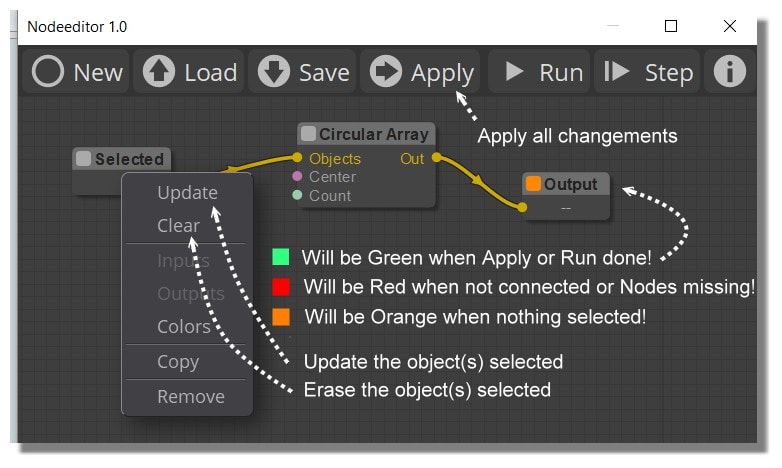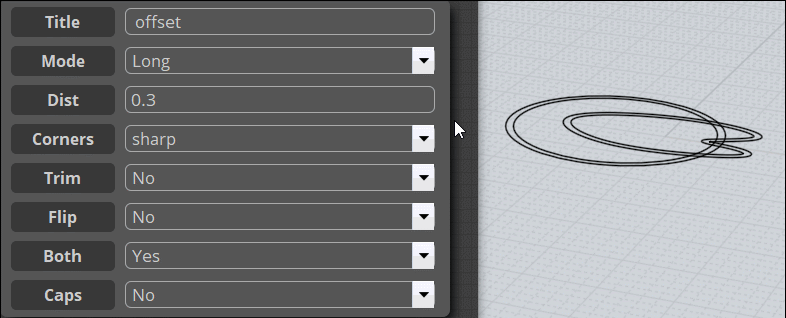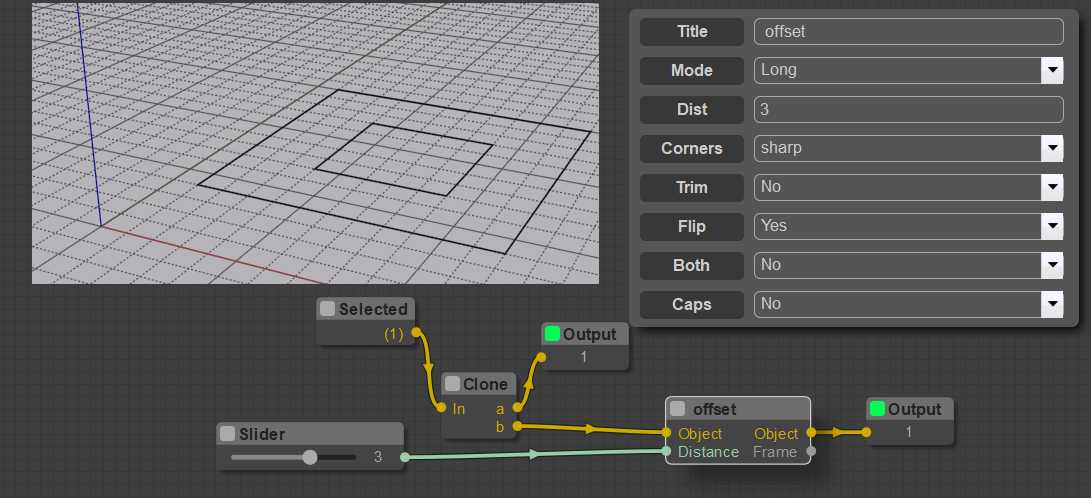Show messages:
1-8
…
1769-1788
1789-1808
1809-1828
1829-1848
1849-1859
Thread Split: Some posts in this thread have been moved here
From: Frenchy Pilou (PILOU)
Problem of Nodes system : when you stop for a while you forget all! :)
Even you have made the Library ! ;)
https://moiscript.weebly.com/basic.html#bibeconcat
From: Psygorn (DRILLBIT)
Thank you Barry-H :)
By the way do you know if it is possible to do this (Selecting certain edges of unioned mesh) or not?

From: Psygorn (DRILLBIT)
I understand PILOU :)
Is there a manual to read and learn the functionality of nodes?
in a glance
https://moiscript.weebly.com/construct.html#bibeunion I was not able to find out how "select" works for example.
Should I keep digging into above link?
or is there another source for learning that kind of things.
From: Frenchy Pilou (PILOU)
You have all nodes here with their explanation so it's not exactly a manual but...
in English...and in French ;)
https://moiscript.weebly.com/biblio-elephant.html
You have Selected Node
https://moiscript.weebly.com/objects.html#bibeselected
and this shows (2 lines bottom) the action on the Select Node on this page :
https://moiscript.weebly.com/node.html

From: Psygorn (DRILLBIT)
Ok
So, digging it is! :)
From: Frenchy Pilou (PILOU)
Bon courage! It's not so evident!
From: Psygorn (DRILLBIT)
Hello guys!
I still have don't know how I could select those edges I had highlighted on the attached photo!
Could anyone help me out here?
From: sunspeed
Dear all,
I tried to use the OFFSET node to create a bigger version of a closed curve object i.e. a rectangle.
When entering a "Dist" number into the editor of this node, i.e.10, the rectangle gets a 10mm negative offset and is getting smaller. Entering negative numbers is not accepted. Switching the "Both" parameter to "YES" is creating both offset rectangles correctly.
My issue now is that I only want to have the bigger rectangle and not both.
Do I misunderstand the node or do I use it in the wrong way?
Thanks in advance for any ideas or proposals how to get this working.
Joerg
Image Attachments:
 Offset Node issue.JPG
Offset Node issue.JPG
From: Frenchy Pilou (PILOU)

I will investigate your problem :)
From: Frenchy Pilou (PILOU)
Maybe like this ?

From: sunspeed
Thanks Pilou!
The FLIP parameter is doing the difference!
Really strange, I was pretty sure that I tested yesterday all parameter including different permutations but always failed. But maybe I simply did not test this combination or the restart of the computer solved the issue.
But however now it works, thanks again Pilou!
From: sunspeed
I need to do some calcs in a MATH node. I am looking for a function like integer(), but this one seems not to exist.
Do you know where I can find a summary about available functions that can be used in the MATH node? I know the simple + - * / PI sin cos tan ( ) but I assume that there might be more ;o))
Thanks, Joerg
From: bemfarmer
See posts by Max, a few years ago.
Also see nodeeditor code, e.g. in notepad++.
See Javascript functions, Ecmascript 5, for example at W3 site
- Brian
From: sunspeed
Thanks Brian. Sometimes it's really the easiest to directly look into the code although Java is not a know language for me. But Max did a very good readable code, so it was easy to simply add the ROUND() function to the list of codes.
In line 78 of basic.js the function can be added:
this.properties = { mode:["Long","Long","Short"], f:"a+b", preset:["a+b", "a+b", "a-b", "a*b", "a/b", "sin[a]", "cos[a]", "pow(a,b)", "round(a)"], a:[1], b:[1]};
Works now perfect for me.
From: bemfarmer
Thankyou sunspeed for sharing your Javascript (5) solution.
- Brian
From: bemfarmer
Is bundlePts available anywhere?
Is bundlePts redundant?
Was bundlePts replaced with some combination of array nodes?
As per Karsten, bundlePts combines the 1st point of each input array, then 2nd point of each input array, etc., which seems to be one of the multi process combinations?
Search of +bundlePts only yields 6 mentions.
- Brian
From: James (JFH)
Brian
"Bundle" node in "ArrayExt" menu is multi-modal: Points, as well as Numbers& Objects.
James
https://www.instagram.com/nodeology/
From: bemfarmer
Thank you James.
So, to clarify my understanding:
The old bundlePts node is redundant, or superceded and replaced.
Instead, under the "ArrayExt" menu, use the "bundleArray" node, in "Points" mode, as a replacement.
- Brian
bundleArray has three modes, Points, Numbers, or Objects. These correspond to input and output pointarrays, numarrays, or objarrays.
bundleArray grabs the 1st element of each input array, and outputs them sequentially in an array.
Then grabs the 2nd elements, and outputs them.
etcetera, to the ends of all of the input arrays.
If an input has less elements that the other inputs, EDIT: THE GRABS STOP. (=Short)
(slice(s) or cross section(s) of arrays?) (Some explanation by Max in multiprocess mode combinations? Short, NOT Long). (See James next post.)
So if the input array elements are arranged in Rows, the output would be the Column elements, sequentially. Or vice-versa.
For example, isoline u elements could be converted to isoline v elements.
Weft could be converted to Warp(???) EDIT: Well, see next two posts for elaboration.
From: James (JFH)
Brian,
quote:
If an input has less elements that the other inputs, it contributes no element for the remaining grabs.
(slice(s) or cross section(s) of arrays?) (Some explanation by Max in multiprocess mode combinations? Long or Long+?)
You have alluded to a flaw in bundle node: effectively it is "Short" list matching only. If you look at the image below,
the final list
should, if it did "long" matching, include "4" at the end. This is also the case with ptArrays & collections of objects.

quote:
So if the input array elements are arranged in Rows, the output would be the Column elements, sequentially. Or vice-versa.
For example, isoline u elements could be converted to isoline v elements. Weft could be converted to Warp.
I'm not clear how bundle node could perform the operation of swapping warp & weft of ptArray, but the means of achieving this would certainly be useful.
James
https://www.instagram.com/nodeology/
See Pilou's post for brief explanation of array matching modes
http://moi3d.com/forum/lmessages.php?webtag=MOI&msg=9476.66Image Attachments:
 bundle_NODE.jpg
bundle_NODE.jpg
From: bemfarmer
Thank you James, for the clarifications, corrections, explanations, and link to Pilou.
They help with my better understanding of the node. What it could do, how it could do it.
I'll try and make some corrections, and elaborations, so as to not mislead.
The weaving was an attempt at an example.
If each input array represented (points of) one warp thread...
Output might represent weft thread location, for additional up/down weave information, somehow ???
- Brian
Show messages:
1-8
…
1769-1788
1789-1808
1809-1828
1829-1848
1849-1859


![]() Offset Node issue.JPG
Offset Node issue.JPG



![]() bundle_NODE.jpg
bundle_NODE.jpg